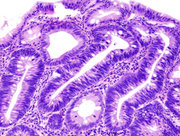Adenoma
Adenoma refers to a collection of growths (-oma) of glandular origin. Adenomas can grow from many organs including the colon, adrenal, pituitary, thyroid, etc. These growths are benign, but some are known to have the potential, over time, to transform to malignancy (at which point they become known as adenocarcinoma.) more...
Histopathology
Adenoma is a benign epithelial tumor arising in epithelium of mucosa (stomach, small intestine and bowel), glands (endocrine and exocrine) and ducts.
In hollow organs (digestive tract) the adenoma grows upwards into the lumen - adenomatous polyp or polypoid adenoma.
Depending on the type of the insertion base, adenoma may be pedunculated (lobular head with a long, slender stalk, covered by normal mucosa) or sessile (broad base).
The adenomatous proliferation is characterized by different degrees of cell dysplasia (atypia or loss of normal differentiation of epithelium): irregular cells with hyperchromatic nuclei, (pseudo)stratified nuclei, nucleolus, decreased mucosecretion and mitosis.
The architecture may be tubular, villous or tubulo-villous. Basement membrane and muscularis mucosae are intact.
Locations
Colon (D12)
Adenomas of the colon are quite prevalent. They are found commonly at colonoscopy. They are removed because of their tendency to become malignant and lead to colon cancer.
Adrenal (D350)
Adrenal adenomas are common (1 in 10 people have them), benign and asymptomatic. They are often found on CAT scans of the abdomen, usually not as the focus of investigation; they are usually incidental findings (incidentalomas). About one in 10,000 is malignant. Thus, a biopsy is rarely called for, especially if the lesion is homogeneous and smaller than 3 centrimeters. Follow-up images in three to six months can confirm the stability of the growth.
Malignant growth of the adrenal is called adrenal adenocarcinoma.
In patients with symptoms of Cushing's syndrome, adrenal adenomas are frequently the focus of glucocorticoid secretion. Surgical resection may be indicated; those unfit for surgery benefit from suppression of the cortisol production with ketoconazole or metyrapone.
Thyroid (D34)
About one in 10 people are found to have solitary thyroid nodules. Investigation is required because a small percentage of these are malignant. Biopsy usually confirms the growth to be an adenoma, but sometimes, excision at surgery is required, especially when the cells found at biopsy are of the follicular type.
Pituitary (D352)
Pituitary adenomas are commonly seen in 10% of the neurological patients. A lot of them remain undiagnosed. Treatment is usually surgical, to which patients generally respond well. The most common subtype, prolactinoma, is seen more often in women, and is frequently diagnosed during pregnancy as the hormone progesterone increases its growth. Medical therapy (bromocriptine) generally suppresses prolactinomas; progesterone antagonist therapy has not proven to be successful.
Read more at Wikipedia.org



